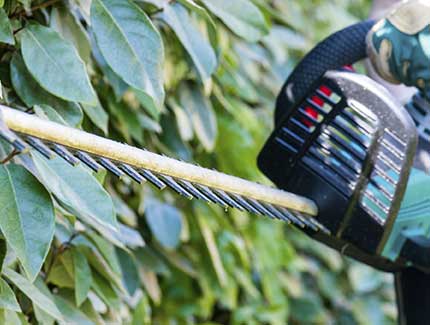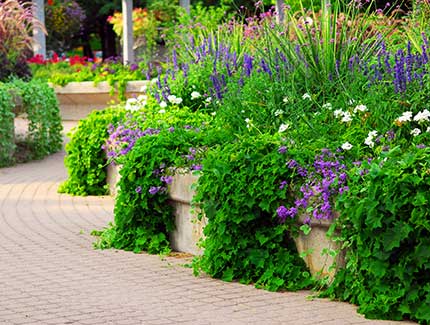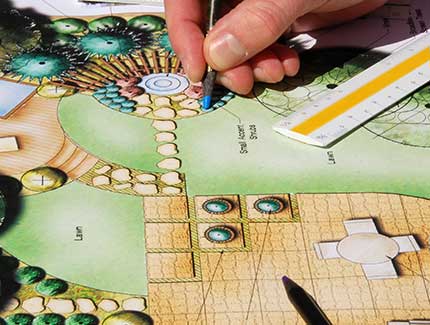Product Care Guidelines
Have we recently completed a project at your property? Use these guidelines to provide the proper care to help your new project thrive.
Sod Care
The three to four weeks after sod is installed is the most crucial time to ensure the roots take hold. Follow these steps to help your new sod survive.
Watering:
- If a water source is available, GreenSweep will complete the initial watering. Otherwise, it is the client's responsibility to water immediately after install. Water thoroughly making the turf almost squishy to step on.
- Water once or twice per day for the first 7 to 14 days depending on the weather conditions. The new sod should be kept wet to a depth of about 5 inches.
- Water in the early morning or early evening when it is less likely for evaporation to occur.
- After day 14, reduce watering to every other day. After day 21, water every 2 to 3 days. After day 28, water as needed.
- The sod may take up to a year to fully establish a root system. Continue to keep an eye on the condition, and water as needed.
- If the sod is not watered properly, it can dry out. The sod will brown, shrink, and can die.
Traffic
- Keep pedestrians, pets, and mowers off the sod for at least 14 days.
Mowing
- Do not mow the sod for 14 to 21 days.
- For the first few cuts, keep the height of the mower blade above 4 inches.
- Never cut more than the top-third of the blades of grass.
Plant Care
We source our plant material from reputable growers and suppliers to provide only high-quality plant material. Keep in mind that landscapes are living - remember all that talk of water, oxygen, light, and photosynthesis from grade school science class! Initial care will be extremely important, but ongoing maintenance is just as much so to ensure the survival of your new investment. While some plants can be lower maintenance, all types will require some level of care and responsibility. Even empty mulch beds must be weeded!
For all plant types, be mindful of transplant shock:
- It is not uncommon for plants to go through a period of shock which may last for about 14 days. After all, it's a living creature and we've just disrupted its home - an adjustment phase can be expected!
- The plant may wilt, brown, or lose its leaves as all the plant's energy is focused on establishing its root system.
- Once the plant regains its strength and acclimates to its new location, new leaf shoots will appear.
Tree Care
Trees can help ground a landscape, provide shade from the elements, or be a focal point on your property. Proper maintenance is required during the entire first year and beyond.
Watering
- If a water source is available, GreenSweep will complete the initial watering. Otherwise, it is the client's responsibility to water immediately after install. Lightly water the base of the tree so the water trickles down to the root ball.
- Water until the soil is moist, but not soggy. Usually approximately 30 to 45 seconds with a steady stream of water from a garden hose is sufficient.
- Water approximately 3 times per week depending on the weather conditions. It may be necessary to water more often during particularly hot, dry weather or less often during rainy weather.
- Water to a depth of about 2 inches. You can check by inserting a garden trowel and rocking back and forth to create a small trench. If the soil is moist to the touch at a depth of 2 inches, further watering is not required at that time.
- Water in the early morning or early evening when it is less likely for evaporation to occur.
- Trees can take up to 2 years for full root establishment. Keep watering during the summer months or other particularly dry times as needed.
Mulching
- Mulching will help the tree's root system retain moisture, as well as provide weed control.
- Cover the soil with compost or high-quality mulch to the drip line (the outer edge of the branches) to insulate the roots during the cold months and retain moisture during hot, dry weather. Mulch should be about 2 to 3 inches in depth.
Pruning
- Pruning/trimming is species-dependent. More information is offered by The National Gardening Association.
Shrub Care
All shrubs chosen for a landscape enhancement or installation will be recommended for our growing region. Watering is critical for all newly-installed plants, along with ongoing maintenance.
Watering
- If a water source is available, GreenSweep will complete the initial watering. Otherwise, it is the client's responsibility to water immediately after install. Using a light stream or mist setting, the water hose should be held above the plant for approximately 60 seconds. Ensure both the base of the shrub and the root ball have received adequate water.
- Continue watering every day for about 14 days.
- After day 14, water every other day for at least an additional 14 days.
- Always monitor the soil conditions, as weather can play a huge role in the amount of water retaining in the soil and thus transferring to the root system.
Mulching
- Mulch is a huge aid in moisture retention, weed control, and insulation.
- Cover the soil with a 2 to 3-inch thick layer of high-quality mulch to insulate the root system during cold weather and protect it from snow/ice, to allow the roots to retain moisture during hot, dry conditions, and to help curb weed growth.
Pruning
- Pruning/trimming is species-dependent. More information is offered by The National Gardening Association.
Perennials & Ornamental Grasses
Perennials and ornamental grasses can provide a lot of visual interest to a landscape.
Watering
- If a water source is available, GreenSweep will complete the initial watering. Otherwise, it is the client's responsibility to water immediately after install. Using a light stream, water directly over the plant for approximately 30 seconds.
- Water every other day in typical seasonal conditions for the first growing season.
- Monitor the weather and increase watering particularly during hot, dry summer months.
- The second growing season should require much less attention, and plants can usually thrive with minimal watering. However, always monitor conditions, and water accordingly.
Mulching
- Mulch will help with water retention and root insulation.
- Cover the soil with a light layer of high-quality mulch.
Pruning
- For perennials, in the fall, dead-head the past season's blooms and any dead growth to allow for new growth in the spring.
- For ornamental grasses, cut back in the winter months if desired to allow for new growth in the spring.
- Pruning/trimming is species-dependent. More information is offered by The National Gardening Association.
Annuals
Annual flowers, such as begonias, vinca, and pansies, are a modest investment that can create a visual pop. Annuals allow for a ton of versatility in your landscape. They are a cheaper alternative with a shorter life cycle, so you can create a fresh look with a new color scheme each season.
Watering
- If a water source is available, GreenSweep will complete the initial watering. Otherwise, it is the client's responsibility to water immediately after install. Using a light stream, water the soil, NOT the petals and leaves.
- Annuals can be watered daily, especially those with long sun exposure. Container planting will be even be more temperamental, so watering is crucial.
Other Notes
- Extend the blooming season by dead-heading any dead or dying blooms. Use your fingers or small pruners to cut off the stems. Remove a bit of the stem, not just the petals, to ensure all the dead plant material is discarded.
- Spring annuals have a shorter life cycle, lasting through late April or early May depending on the air and soil temperatures. Summer annuals are grown to withstand hot and dry conditions and typically last May through September. Summer annuals also tend to grow larger and fill up a space more completely, but they are not strong enough to withstand the cold. Summer annuals are replaced with fall flowers which are hardy enough to withstand the cold weather and may even tolerate the entire winter season.
Hardscape Care
- Be mindful of settling for any hardscape set in a sand or stone dust base. Be mindful of water puddling on the surface of any new hardscape. Notify us immediately so we can resolve any issues.
- Keep newly-laid concrete surfaces, including flagstone set in concrete base, clear of pedestrians, pets, outdoor furniture and décor, planting pots, etc. for at least 48 hours after installation.
- Wood decking or fences may need to be stained or water-proofed due to normal wear and tear, but any stain or treatment should occur at least 30 days after installation.


